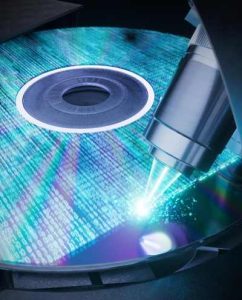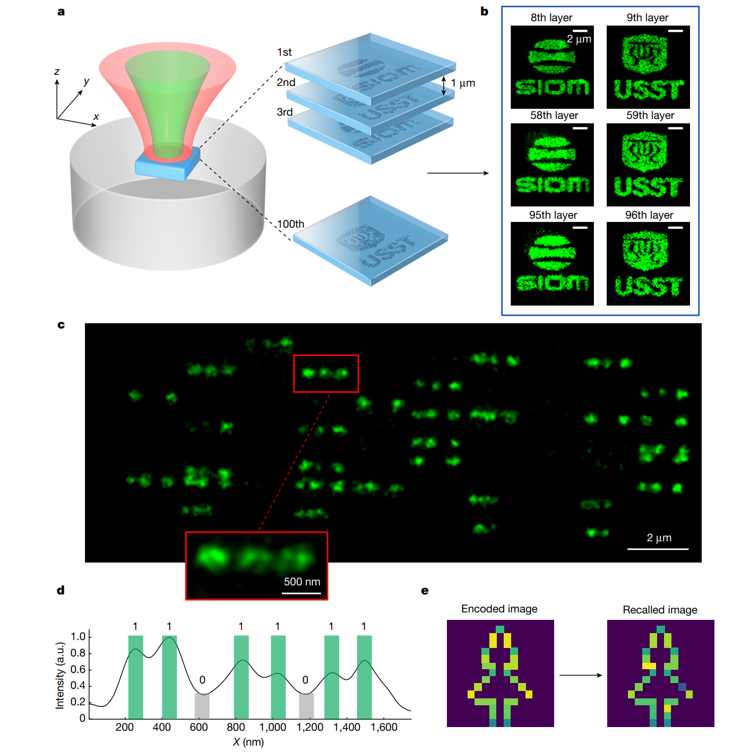University of Shanghai for Science and Technology Researchers Develops Up to 1 Petabit Optical Disk and Writing Technology
By extending planar recording architecture to 3D with hundreds of layers, meanwhile breaking optical diffraction limit barrier of recorded spots
This is a Press Release edited by StorageNewsletter.com on February 27, 2024 at 2:01 pmFrom University of Shanghai for Science and Technology
The most popular words of year 2023 were recently released, and AI Large Language Model (LLM), without any doubt, is on the top of the ranking. As a front runner, ChatGPT was also selected as 1 of the international buzzwords of the year. For all these innovations in the field of AI, big data have played a very significant role. Meanwhile, AI has also brought new opportunities and challenges to the development of big data.
Storage with high capacity is crucial in today’s digital economy. But major storage devices such as HDDs and semiconductor flash devices have limitations in terms of cost-effectiveness, durability and longevity. Optical storage presents a promising green solution for cost-effective and long-term data storage. However, the optical storage has a fundamental limitation in terms of the spacing of 2 adjacent recorded features caused by the fundamental optical diffraction limit. This physical limit poses a barrier to the further development of optical lithographic machines, and also to optical microscopy and optical storage technology. Among the 125 cutting-edge scientific problems released by Science in 2021, breaking the diffraction-limited barrier ranks the first in the field of physics. It is also one of the 7 technology breakthroughs that Nature has predicted for 2024 and beyond.
The researchers from a multidisciplinary team led by Professor Min Gu, University of Shanghai for Science and Technology (USST), and Shanghai Institute of Optics and Fine Mechanics (SIOM), Chinese Academy of Sciences have jointly overcome the above challenge. They published their latest research achievement with a title of A 3D nanoscale optical disk memory with petabit capacity in Nature. Researchers have demonstrated for the 1st time the capacity of optical storage can be up to the petabit (Pb) level by extending the planar recording architecture to 3 dimensions with hundreds of layers, meanwhile breaking the optical diffraction limit barrier of the recorded spots.
The capacity within the area of a DVD-sized disc can reach up to petabit level, equivalent to at least 10,000 blue ray discs or 100 high-capacity HDDs. The corresponding authors of the paper are Professor Min Gu, director, Institute of Photonic Chips and professor Jing Wen, USST and professor Hao Ruan, SIOM. Dr. Miao Zhao, a postdoctoral fellow at SIOM, and professor Jing Wen from USST are both listed as co-1st authors.

The 3D nanoscale optical disk memory with petabit capacity is a groundbreaking technology. The dataset behind GPT, such as the total number of indexed web pages reaching 5.8 billion and the text size of the entire internet being about 56Pb, would require a playground area of HDDs to store these data. However, the 3D nanoscale optical disk memory can shrink the space to the size of a desktop computer, greatly reducing the costs. In addition, in order to maintain the strict operating environment of the database (constant temperature and humidity, anti-magnetic and dust prevention), the energy consumption is huge. In 2022, the total power consumption of China’s data centers is about 270 billion kW hours, exceeding the total power generation of 2 ‘Three Gorges hydropower stations’. The biggest headache is that regular data migration is required every 3-10 years, which poses risks of tampering and loss of the data and short lifespan. The energy consumption of nanoscale optical disk memory is several orders of magnitude lower, and its lifespan can reach up to 50-100 years.
Click to enlarge

To break the optical diffraction-limited barrier for optical lithography, in 2013, professor Min Gu, with his research team, achieved 9-nanometer lithography technology based on the mechanism of dual-beam writing. German scientist professor Stefan W. Hell won the 2014 Nobel Prize in Chemistry for the invention of dual beam super-resolution microscopic imaging technology. The 3D nanoscale optical disk memory technology published in Nature this time successfully breaks the diffraction-limited barrier for optical writing and reading, and will usher into a new era of the digital economy of big data.
Article: A 3D nanoscale optical disk memory with petabit capacity
Nature has published an article written by Miao Zhao, Photonic Integrated Circuits Center, Shanghai Institute of Optics and Fine Mechanics, Chinese Academy of Sciences, Shanghai, China, Jing Wen, Engineering Research Center of Optical Instrument and Systems, Ministry of Education and Shanghai Key Lab of Modern Optical System, University of Shanghai for Science and Technology, Shanghai, China, Qiao Hu, Photonic Integrated Circuits Center, Shanghai Institute of Optics and Fine Mechanics, Chinese Academy of Sciences, Shanghai, China, Xunbin Wei, Biomedical Engineering Department, Peking University, Beijing, China, and School of Biomedical Engineering, Anhui Medical University, Hefei, China, Yu-Wu Zhong, Key Laboratory of Photochemistry, Beijing National Laboratory for Molecular Sciences, CAS Research Education Center for Excellence in Molecular Science, Institute of Chemistry, Chinese Academy of Sciences, Beijing, China, Hao Ruan, Photonic Integrated Circuits Center, Shanghai Institute of Optics and Fine Mechanics, Chinese Academy of Sciences, Shanghai, China, and Min Gu, Institute of Photonic Chips, University of Shanghai for Science and Technology, Shanghai, China, and Zhangjiang Laboratory, Shanghai, China.
Abstract: “High-capacity storage technologies are needed to meet our ever-growing data demands1,2. However, data centres based on major storage technologies such as semiconductor flash devices and hard disk drives have high energy burdens, high operation costs and short lifespans2,3. Optical data storage (ODS) presents a promising solution for cost-effective long-term archival data storage. Nonetheless, ODS has been limited by its low capacity and the challenge of increasing its areal density4,5. Here, to address these issues, we increase the capacity of ODS to the petabit level by extending the planar recording architecture to three dimensions with hundreds of layers, meanwhile breaking the optical diffraction limit barrier of the recorded spots. We develop an optical recording medium based on a photoresist film doped with aggregation-induced emission dye, which can be optically stimulated by femtosecond laser beams. This film is highly transparent and uniform, and the aggregation-induced emission phenomenon provides the storage mechanism. It can also be inhibited by another deactivating beam, resulting in a recording spot with a super-resolution scale. This technology makes it possible to achieve exabit-level storage by stacking nanoscale disks into arrays, which is essential in big data centres with limited space.“















 Subscribe to our free daily newsletter
Subscribe to our free daily newsletter

